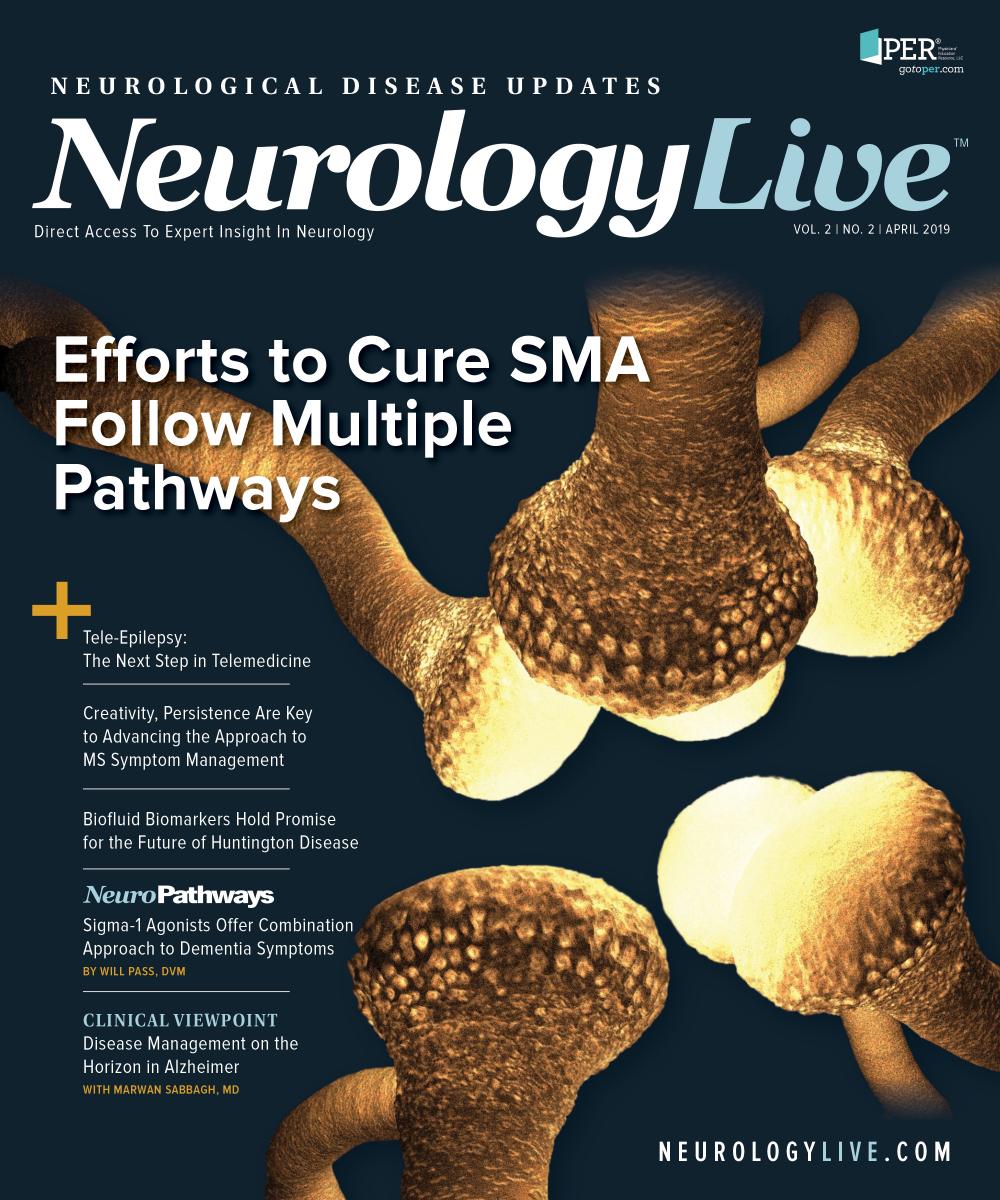Publication
Article
NeurologyLive
Biofluid Biomarkers Hold Promise for the Future of Huntington Disease
Author(s):
Currently, there are no disease-modifying medications for Huntington disease and few interventions available to effectively alleviate symptoms, while the lack of indicators of pathobiological processes at the molecular level has limited the ability to prove efficacy and safety in clinical trials.

Peter LeWitt, MD
Huntington disease (HD), a genetically dominant trinucleotide repeat disorder resulting from cytosine-adenine-guanine (CAG) repeats within the huntingtin (HTT) gene, has a near-full pene- trance and onset of symptomatology and neuronal loss typically by the third decade of life.
A neuropathological hallmark of HD is cortical atrophy, as indicated in postmortem assessments. These studies have been limited, however, because the assessments were performed on tissue of neuropathological grades 2-4. Cortical atrophy at early stages of HD, before symptoms develop, remains unclear.
There have been few reliable and quantifiable indicators of disease severity, progression, or phenotype, which has limited therapy development. Currently, there are no disease-modifying medications and few interventions available to effectively alleviate symptoms. The lack of indicators of pathobiological processes at the molecular level has limited the ability to prove efficacy and safety in clinical trials.
“Symptomatic treatment currently available targets the involuntary movements, particularly features of chorea,” Peter LeWitt, MD, the program director of the Movement Disorders Fellowship at Henry Ford Hospital and editor in chief of Clinical Neuropharmacology, told NeurologyLive. “Suppressing these movements can be achieved with drugs that block or deplete dopamine neurotransmission. Benzodiazepine medication can also be effective.”
“The goal of a disease-modifying therapy for HD would be preventing the actions of the mutant HTT gene so that only normal huntingtin protein can be produced—or, possibly, completely blocking all expression from both the mutant and wild-type genes,” LeWitt added.
Identifying ways to reduce the burden of mutant huntingtin (mHTT) protein in the brain has been the focus for developing new therapies for HD. It is critically important to identify biomarkers that are sensitive to the effects of an intervention on mHTT in order to determine whether it has been effective. Biofluid biomarkers may provide advantages, in addition to clinical measures, such as reliability, reproducibility, price, accuracy, and direct quantification of pathobiological processes at the molecular level. They have the potential to generate useful hypotheses for new drug development and empower clinical trials.1
“In order for biomarkers to be used [to help] give patients clinical advice, we need a very high standard of evidence,” Edward Wild, MA, MB BChir, FRCP, PhD, MRC, a clinician scientist at the University College London (UCL) Institute of Neurology and a principal investigator at UCL Huntington’s Disease Centre, told NeurologyLive. “The current information that we give to patients is the genetic test result. While there are no treatments that work, there isn’t a great deal of enthusiasm among most of our patients for finding out whether they’re likely to develop the disease much earlier than expected or later than expected.”
Wild expressed his hope in eventually having both multiple drugs that are effective and the means to determine which patients are most likely to benefit. “These biomarkers are likely to find a very useful role there in the future. And not the distant future, either,” he said.
A Potential Disease-Modifying Therapy for HD?
Data have shown that the role of oxidative stress is crucial in the pathogenesis of HD.2 There are several explanations for the source of this oxidative stress in the literature. Rotblat et al found that mHTT can serve as the source of reactive oxygen species (ROS).3 Electron transport chain impairment and mitochondrial dysfunction are involved in ROS-mediated pathogenesis of HD, as found by Trushina and McMurray.4 Chen et al found that an increased level of oxidative stress markers was accompanied by a decrease in antioxidant status in patients with HD compared with healthy subjects.5
In a case study of a 42-year-old patient with HD, electron microscopy of an axillary skin biopsy showed distinctive mitochondrial abnormalities that were limited to apocrine secretory cells.6 The organelles were transformed into rounded structures, and some were enlarged up to 4 times the normal diameters. There was a dense matrix resulting from disrupted cristae and prominent myelin figures, as well as an abundance of lipid vacuoles, empty vesicles, and dense bodies within the cytoplasm of the apocrine secretory cells. In 3 of the patient’s 4 children, axillary skin biopsies showed the same mitochondrial abnormalities in apocrine secretory cells. These abnormalities have also been described in ultrastructural studies of brain biopsies of young- and adult-onset HD.7 Investigators suggested that these mitochondrial abnormalities could have useful application for phenotypic expression of HD where altered energy metabolism and other dysfunctions of mitochondria are concerened.
“It’s very clear that metabolic efficiency of cells is diminished in patients with HD, but it’s less clear why,” Wild said. “The advantage that we have in HD is that we have this gene that is the known cause of every single case of HD. Once this gene is expressed, the protein causes a huge, diverse array of harms, and one of those harms is to mitochondrial function.”
On March 5, 2019, Mitochon Pharmaceuticals received an orphan drug designation from the FDA for MP-101, a mitochondrial-targeted compound for the treatment of HD.8 This move will help the company continue to pursue clinical development of MP-101, a repurposed molecule that was granted a US patent in November 2017 (US 15/002,531). In preclinical studies, MP-101 was shown to preserve brain volume, medium spiny neurons, and general neurons and to significantly guard against ROS in the cortex, which could alter disease progression in HD. The drug is delivered as a once-daily oral therapy.
“We are delighted to receive our first orphan drug designation for Huntington disease, a devastating neurodegenerative disorder with no disease-modifying therapies on the market today,” Robert Alonso, co-founder and CEO of Mitochon Pharmaceuticals, said in a statement. “By harnessing the power of the mitochondria, MP-101 has been shown to protect both spiny neurons and general neurons, as well as minimize brain volume loss from the destructive effects of Huntington disease. Together, these effects have the potential to significantly change the progression of the disease in patients. This designation is an important milestone for Mitochon, and we are excited to move into patients and help the thousands of families with Huntington disease.”
“Preclinical data show we can spare spiny neurons,” Alonso continued. “The drug should have a disease-modifying effect.”
A 14-day phase 1 clinical trial with normal, healthy volunteers will take place at Mayo Clinic this year, followed by a phase 2 trial planned for 2020 in which oxidative stress will be measured by examining the effects of MP-101 on mitochondrial function.
“This could be an important breakthrough for the many families suffering from HD,” Alonso told NeurologyLive. “If successful, we would hope that patients with HD could live without the constant fear of disease progression or at least with the knowledge that they are blunting its path.”
A New Era of Huntingtin Lowering
The first successful huntingtin-lowering drug, an antisense oligonucleotide (ASO), interacts with the RNA that is produced by the HTT gene. Although not a gene therapy per se, treatment with ASOs alters the expression of the HTT gene as a possible strategy to arrest disease progression. These ASOs can be given intrathecally; they do not requirie neurosurgery or anything more invasive. They are also reversible; stopping the drug will result in elimination from the patient in a few weeks.9
“We are now in the era of huntingtin lowering,” Wild said. “We know that we can do it. We have successfully lowered mHTT in the nervous system, using ASO in the CSF [cerebrospinal fluid] and then measuring the huntingtin level a month later. The next generation of therapies may well be gene therapies. These will be virally delivered drugs that will interfere with the expression of the gene.”
The virus will infect neurons, transforming them into factories that manufacture the drug. The neuron will contain the huntingtin mutation, but it will also instruct the cell to make another molecule that shuts off the expression of that gene. It’s appealing because it’s a treatment that could last many years, potentially throughout a patient’s lifetime. However, the danger to this approach is that it would be difficult or perhaps impossible to “turn off” the drug.
“We need to think carefully about how to give these drugs, what the right doses are, and what to do if side effects do emerge, how we might mitigate that,” said Wild. “I’ve been saying, since I started in HD 15 years ago, that the era of gene therapy is coming. Now we are truly in that era, and what we need to do is figure out the best drugs to give it, the best way to assess efficacy and safety. And the next thing will be to figure out the best combination of drugs for each individual patient.”
New Data on Potential Efficacy of AMT-130
Recently, encouraging preclinical data on AMT-130, a gene therapy which carries a DNA cassette that encodes a microRNA that non-selectively knocks down human huntingtin protein in patients with HD, were suggestive of the treatment’s potential in HD. The data were presented at the 14th Annual Huntington’s Disease Therapeutics Conference held in Palm Springs, California, from February 25 to 28.10
AMT-130 is delivered via a noninfectious adeno-associated virus (AAV5) and contains microRNA. It acts by binding the mRNA that gives origin to HTT, thus marking HTT’s mRNA for degradation and preventing production of the faulty protein. The efficacy of noninvasive magnetic resonance spectroscopy (MRS) to measure biomarkers and monitor the function of AMT-130 in mouse brain cells was described in a poster, “Magnetic Resonance Spectroscopy [MRS]) Shows Restoration of Neuronal Function in a HD Mouse Treated With AMT-130.”10
AMT-130 was administered into the striatum and thalamus of minipigs. Three months after treatment, dose-dependent distribution of AAV5 that was widespread and observed throughout the brains of the pigs. Production of the huntingtin protein decreased by more than 50% in all regions of the brain where AMT-130 was found.
“Findings from our preclinical studies illustrate the therapeutic potential of AMT-130 in restoring function to damaged brain cells in Huntington disease and providing a safe and sustained reduction of mutant huntingtin protein with a gene therapy candidate that could be applicable to a broad patient population,” Sander van Deventer, MD, PhD, chief scientific officer at uniQure, said in a statement.
Crucial Identification and Quantification of Biofluid Biomarkers
Identifying biofluid biomarkers in HD has the potential to provide complementary information on disease stage and progression, in tandem with imaging studies.11 Comparison of neurofilament light (NfL) protein and mHTT as potential biomarkers of HD found that they each offer distinct advantages in identifying potential targets for therapies.12
“What we showed is that they both have great potential,” said Wild, who co-authored the study. “Mutant huntingtin is what causes HD, the thing that most of the new drug trials are trying to target, whereas NfL is a really good measure of the health of the neurons. So, the 2 of them together form a really powerful toolkit. What we showed using our data was that NfL seems to be the best predictor of clinical status.”
Wild and colleagues have finished a 2-year follow-up to this study, which is a longitudinal assessment in the HD CSF study. They’re working to determine whether the baseline NfL level is an independent predictor of subsequent progression. The participants have all been seen again, and most donated more blood and CSF.
“We are now in the process of analyzing the longitudinal data to find out what changes over time with the biomarkers—not just with NfL and mHTT, [although] we still think those are the most important two,” said Wild. “We’re also looking at a wider range
of proteins, which are new and haven’t been looked at before in HD, and these are proteins like glial fibrillary acidic protein or ubiquitin C-terminal hydrolase L1, which are used in head injuries and strokes. We hope to produce quite quickly a longitudinal follow-up paper, which basically says how these biomarkers change over time, which becomes critically important in designing clinical trials.”
Future Clinical Implications of Useful Biomarkers
In just the last 5 years, there has been significant progress in using biofluid biomarkers to study and predict HD progression and therapeutic response. Still, questions remain, including how validated biomarkers will affect clinical decision making.
“If it were me 5 years from now and I’ve got a choice between a pill that lowers huntingtin by 10% or an injection into the spine that might lower huntingtin by 50% but is riskier, I’m going to want information about the patient to help decide which is the best treatment,” Wild said. “Part of that would be how much mHTT is floating around in the nervous system and part of it is how healthy are the neurons. I think that combination of mHTT and NfL in either CSF or blood is going to [be] a really useful pair of signposts as to whether someone is on a riskier or less rapid trajectory compared [with] other people with similar genetic test results and age.”
Wild noted that at this point in time, all hypotheses need to be pursued, even those that are far downstream from the HTT gene, because there are no treatments.
“We need to keep our minds open to anything that might help. We need a solid rationale for why the drug is likely to help,” he said. The challenge, he explained, is proving that a drug can hit the specified target and is working in the way it should. Its clinical benefit needs to be determined, which Wild noted cannot be done without a long-term clinical trial.
“At some point in the future, we could say that lowering NfL always produces clinical benefit,” he concluded. “If we end up in that situation, we might be able to start using NfL or some other biomarker as a reliable predictor of subsequent clinical efficacy. But we’re not there yet.”
REFERENCES
1. Rodrigues FB, Byrne LM, Wild EJ. Biofluid biomarkers in Huntington’s disease. Methods Mol Biol. 2018;1780:329-396. doi: 10.1007/978-1-4939-7825-0_17.
2. Kumar A, Ratan RR. Oxidative stress and Huntington’s disease: the good, the bad, and the ugly. J Huntingtons Dis. 2016;5(3):217-237. doi: 10.3233/JHD-160205.
3. Rotblat B, Southwell AL, Ehrnhoefer DE, et al. HACE1 reduces oxidative stress and mutant Huntingtin toxicity by promoting the NRF2 response. Proc Natl Acad Sci USA. 2014;111(8):3032- 3037. doi: 10.1073/pnas.1314421111.
4. Trushina E, McMurray CT. Oxidative stress and mitochondrial dysfunction in neurodegenerative diseases. Neuroscience. 2007;145(5):1233-1248.
5. Chen CM, Wu YR, Cheng ML, et al. Increased oxidative damage and mitochondrial abnormalities in the peripheral blood of Huntington’s disease patients. Biochem Biophys Res Commun. 2007;359(2):335-340.
6. Sidiropoulos C, LeWitt P, Hashimoto K. Abnormal apocrine secretory cell mitochondria in a Huntington disease patient. J Neurol Sci. 2012;323(1-2):261-263. doi: 10.1016/j.jns.2012.08.034.
7. Tellez-Nagel I, Johnson AB, Terry RD. Studies on brain biopsies of patients with Huntington’s chorea. J Neuropathol Exp Neurol. 1974;33(2):308-32.
8. Mitochon Pharmaceuticals awarded orphan drug designation [press release]. Blue Bell, PA: Mitochon Pharmaceuticals; March 5, 2019. mitochonpharma.com/news/mitochon-pharmaceuti- cals-awarded-orphan-drug-designation. Accessed March 6, 2019.
9. Tabrizi SJ, Ghosh R, Leavitt BR. Huntingtin lowering strategies for disease modification in Huntington’s disease. Neuron. 2019;101(5):801-819. doi: 10.1016/j.neuron.2019.01.039.
10. uniQure presents new preclinical data on AMT-130 at the CHDI’s 14th Annual Huntington’s Disease Therapeutics Conference [press release]. Lexington, MA: uniQure; February 27, 2019. globenewswire.com/news-release/2019/02/27/1743286/0/en/uniQure-Presents-New-Preclinical- Data-on-AMT-130-at-the-CHDI-s-14th-Annual-Huntington-s-Disease-Therapeutics-Conference. html. Accessed March 1, 2019.
11. Zeun P, Scahill RI, Tabrizi SJ, Wild WJ. Fluid and imaging biomarkers for Huntington’s disease. Mol Cell Neurosci. Published online February 23, 2019. doi: 10.1016/j.mcn.2019.02.004.
12. Byrne LM, Rodrigues FB, Johnson EB, et al. Evaluation of mutant huntingtin and neurofilament proteins as potential markers in Huntington’s disease. Sci Transl Med. 2018;10(458). doi: 10.1126/ scitranslmed.aat7108.






